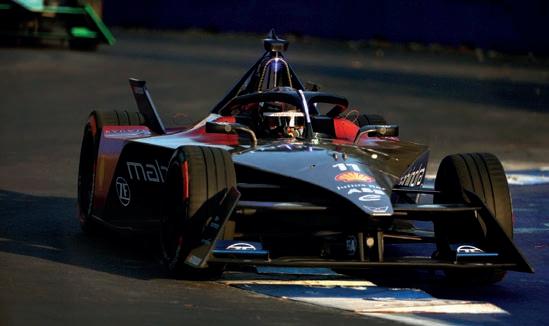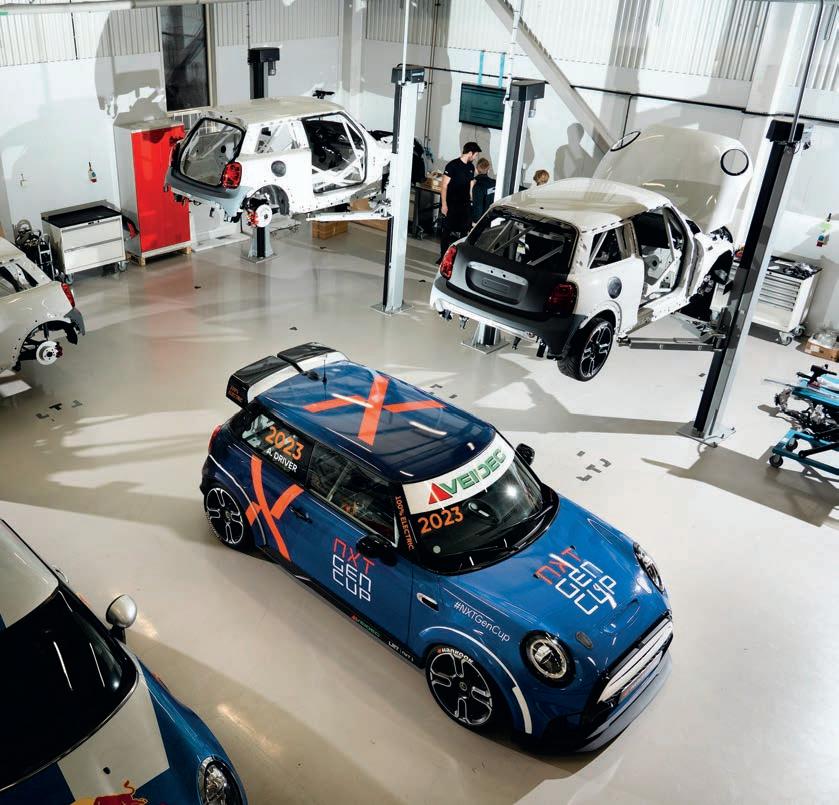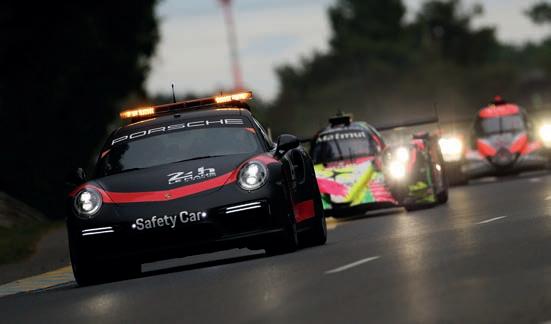
11 minute read
Push for performance
By DIETER RENCKEN
The Formula 1 paddock’s demographic is generally binary: folk who are in the sport because they love it above all else, and those who are attracted by the world class standards demanded from every pass holder, regardless of discipline, be it in hospitality, marketing, logistics, engineering, on the sporting side or wherever.
Occasionally, though, individuals are attracted to F1 due to its exacting demands, and then develop a deep love for the wider sport, acquiring that crucial winning ethic and with it, an unquenchable thirst for on-track success that simply does not exist outside of motorsport.
One such engineer is Matt Harman, technical director for Alpine F1 Team, effectively the chassis side of the operation, based in Enstone, Oxfordshire. Harman’s pre-F1 background was in civilian and military engines, having cut his technical teeth at Shoreham, UK-based Ricardo – the global strategic, environmental, and engineering consulting company which focuses on transportation solutions – as a test and calibration engineer
‘I absolutely loved that company, it was one of the best engineering groundings,’ the now 45-year old tells Racecar during an exclusive interview in early December at the team’s base.
With the hectic of the team’s fight for the ‘best of the rest’ title after Red Bull, Mercedes and Ferrari done and dusted, the engineerturned-racer has time to share his journey from experimentation to Formula 1.
‘We did so many things [at Ricardo],’ he recalls. ‘Every six months you would do a new project, so anything from a Mitsubishi GDi single cylinder [test engine] to a [MotoGP] Sauber-Petronas twin – I actually ran that project on the dynamometer – to a 2000bar, 36-litre, common rail diesel tank engine for Iveco for the Italian Army.


‘I learned an awful lot about the fundamentals of how things worked, particularly on the power units of that era. Then, in 2000, my boss at the time moved to Ilmor (now Mercedes High Performance Powertrains) to look after their test systems. He invited me to apply, so to speak…’
Career path
Harman actually started at Ilmor – founded by ex-Cosworth engineers, Mario Ilien and Paul Morgan – in test engineering before moving into the design office and then onto power unit development. This progression through the company exposed him to various areas, including the full spectrum of flywheel, hydraulic and electronic energy recovery and hybrid systems, which by then had become vogue in F1.
‘When Andy Cowell came in [from Cosworth] he made me in charge of valvetrain. I was lucky, I obviously had a bit of potential, so they moved me around to different areas. I stayed there until I did the installation of the Mercedes engine into the Brawn for 2009 [after the entire Honda project, minus PU, was handed over to Ross Brawn].
‘That wasn’t easy, but it was exciting, and that’s where I got to know Ross and Bob [Bell, who later returned to Renault]. After a while,

Ross called and asked whether I’d like to come over [from HPP to the Mercedes F1 Team] to look after PU and chassis integration stuff, ultimately for the hybrid 2014 car.’



F1 politics
That period also exposed Harman to F1’s vicious politics. Virtually overnight, the PU was changed from an inline four to a V6, and its introduction pushed out a year from the original 2013 after Ferrari and Mercedes argued for V6s on the basis they would never build a four-cylinder F1 engine, while Renault dug in on the original architecture. The big guns eventually won the drawn-out battle.
‘It was a tricky time, because we put an awful lot of work in the bin,’ Harman smiles wryly. ‘My focus was the 2014 car. At the time, I was working for Aldo [Costa] who was a great supporter of mine, I owe him a lot for that. I stayed [with Mercedes] until 2018, doing lots of different projects, taking control of the front and rear ends and doing various things, basically learning the full trade.’
During his initial period at Mercedes, he held the title of engineering team leader, remaining in that position for 11 years, before becoming head of powertrain integration and transmission design for the Mercedes F1 operation between 2011 and 2018.
Given these responsibilities, it is obvious that Harman amassed a wealth of experience in integrating the main elements of a racecar, namely chassis and powertrain.
It was therefore no surprise that in 2018 he took a call inviting him to join the then Renault F1 Team, for which Bell consulted after his Mercedes spell as chief designer.
The team had a multi-title history with Michael Schumacher and Fernando Alonso, but had gone off the boil after a plethora of ownership changes and lack of investment.
Harman’s first project was the Renault RS21, originally planned for F1’s ‘new era’, which was in turn pushed out a year due to the pandemic. Eventually, the car took to the grid as the Alpine A522 after an internal name change of the team.
‘I did that car from September 2018, and then having come here and looked around, and actually laying out the car, I realised we needed a 100-race plan,’ he said. ‘We also needed to change our approach and our way forward, so that’s what we’ve done.
‘When I took the role of engineering director a year later, and then that of technical director in February 2022, I tried to ensure that not only have we got the right technologies going in the car and the right targets, but also looked at the architectures we’ve got, capabilities, people and the culture to be at the very front. It is all about having a culture, and we needed that. I’m proud of what we’ve done because we are moving in that direction. We’re really starting to get that more relentless, tenacious focus on driving forward, which for me is very satisfying to see.’
Clearly, these words come from a now committed F1 man, rather than the engineer who once designed diesel engines for road cars and bi-turbos for military applications.
Although Harman readily admits the power unit itself falls outside of his direct area of responsibility (that’s the domain of
Bruno Famin, previously with the FIA and Peugeot Motorsport in endurance racing before that), a successful F1 car needs the absolute best of everything, and it would be an utter waste for Alpine to not tap into the Briton’s experience in this regard.

Competitive power
Crucially, with an engine freeze looming, this meant that going the conservative route could leave Alpine short on power through to the 2026 regulation change.
‘It’s been well publicised that I’m not responsible for the power unit, [but] I set the specification for the engine and what we wanted, not only in terms of its architecture, but its overall performance.
‘In the end, we had to make a decision that we thought was right for everybody, that we would push on the performance and take the risk on reliability. Honestly, if I had my time again, I’d make the same decision, it is massively important in this homologated era that we have the performance we need. We must have a competitive power unit. In my mind, we have now got one that is close enough that we can compete. I’d like to honestly thank everybody in Viry for the hard work they did in those years because it was very difficult.’
The Viry reference is to Renault F1’s engine division situated in Viry-Châtillon, south of Paris, which gives some idea of the cultural and geographic challenges facing the team.
‘I set the architecture for that engine, and they delivered the architecture. We had some reliability concerns and these cost us in our championships, but I don’t believe they ultimately cost us in the final [2022] position. But it did make our season more stressful.’
For the record, Mercedes finished the season 342 points ahead in third, while McLaren was 14 in arrears in fifth.
Once again, though, the racer in Harman comes to the fore: ‘We didn’t do it in the style we’d have liked to have done it, but we’ve learned a lot about that particular engine and that new architecture, and I’m pretty confident about a better 2023 from looking at all the root causes. We won’t be repeating our problems, and we’re looking at having that performance in both reliability and kilowatts.’
Given their relatively short Alpine career histories – Famin only joined the team in March 2022 – a close cooperation between the two engineers is crucial, particularly if they wish to exploit the considerable advantages of an in-house powertrain without the drag of satisfying customer teams.
Manufacturer of Embedded Sensor Solutions Since 1999















Consequently, Harman also has an office in Viry, which he regularly visits, and says one of his first priorities as chief designer was to bring the two companies closer together.
‘We need to be a full works team, not a semi-customer team,’ he stresses. ‘We can’t be a team where we’re provided with a product to put in the back of our car, we need to be creating a total product together. Now we have engineers that are connected, the engineer who does the integration of cooling system parts on the engine is totally in tune with the engineering team doing the car’s cooling systems.
‘We’ve got all of those sorts of connections happening across both companies. With the exception of geography, it feels like we’re all in the same office. That is really important.’
Equally crucial are the synergies between the two technical directors, situated either side of the English Channel. Harman is adamant they are aligned in their views and is bullish that 2023’s results will reflect that close cooperation and commitment to the project.
‘That helps a lot, we both agree on what performance is. We agree that being courageous in performance is the only way we’re going to get to where we want to go. We’re not going to get there by being risk averse, or by worrying about making courageous moves.
‘We need to make those moves and we need to put the people in place to deliver them. Bruno is a highly experienced engine engineer and, between the two of us, you’ll see that next year will be a much better show.’
Given that the team finished fourth, ahead of McLaren, in the 2022 Constructors’ Championship, that is a bold prediction, one which should them snapping at the heels of Mercedes and Ferrari if realised.
Zero distraction
While many perceive the lack of a customer team (Mercedes services its own team plus three, while Ferrari supplies one plus two) to be a disadvantage due to reduced running data, Harman points to the positive: zero contradictory demands from pesky customers.
‘That is a massive advantage in that there is no distraction. Having lived through being a works team and supplying others, and working on the engine side as well, where we would have supplied others, I know there is always an element of distraction and there are always things you have to compromise on to make sure your power unit can fairly interact with other chassis.’ Note the use of the word fairly.
‘With us, we don’t have any of that, so our conversations are all about first principles engineering, or about how we’re going to design the architecture of an engine and how it fits in a car organically. We don’t have any conversations about compromises.
‘The only disadvantage there can be is that [with customer teams] there are other engines out there and they’re all engineering a similar problem. There are some great engineers everywhere, and customer teams do bring something to the party. They may well come up with an idea and, in the act of adapting the engine to satisfy that idea, you could learn something.
‘Sometimes you miss out from some of that information, and also you miss out a little bit on reliability, but in my previous experience it’s also the case that customers haven’t always run the latest in equipment, so you don’t really benefit that much.
‘On the reliability side, it can be beneficial. You learn a lot by having more samples, and we suffered from that this year,’ he admits. ‘But the freedom of thought, and freedom of exploiting what you want to do in your car without hindrances makes up for that.’
In closing our 40-minute interview, which was preceded by a full and enlightening tour of the Enstone facility, we address the question of road relevance and Harman reveals that Alpine F1 Team is providing consultancy services to the wider Renault group via the in-house Alpine Laboratory.
‘Alpine Lab is akin to a [Mercedes] Applied Science or Red Bull Advanced Technology,’ he explains. ‘It’s a similar sort of organisation doing technology projects with certain specialisms within the wider group.
‘There are also technologies and expertise that come to the F1 environment to help us with shortfalls in our resources. It’s working for us, and it’s a nice string to our bow in that it brings Alpine Cars, Renault Group and the Enstone F1 team closer together because the projects are multi-disciplinary and need our input on top of the Formula 1 product.’
In that regard, it seems the career of this consultant engineer-turned-racecar engineer has come full circle, and in the interim has acquired that winning edge that is so crucial to success in all areas of motorsport, but none more so than Formula 1.

Harman on 2026
RE: Although the 2026 power unit regulations have essentially been approved, much work remains to be done on their chassis equivalents before these are finalised at the end of 2023. Given that Harman is one of few F1 engineers with in-depth experience across both disciplines, how does he feel about the sport’s future, particularly talk of active aerodynamics, active suspension and all-wheel drive?
MH: We have been looking at those things, but we don’t treat the regulations as a power unit thing or a chassis thing, we treat the whole project as a car.
Taking the points in bitesized chunks, I think active aero is a good thing. If it just adds more functionality on the wings it will add another dimension to driver input, how that works and how they select things.
But I think for drivers it’s a bit of a worry because it’s not going to make the cars any lighter. We should also be looking to solve the recovery issue without having to go to full recovery [via 4WD], and obviously our Viry colleagues are heavily into that with their partners.
RC: If you have active aero you need active suspension…
MH: It’s a topic that comes back every two or three years. We’ve had hydraulic suspension systems in the past, which are basically trying to mimic active suspension such as FRICS (Front-Rear InterConnected Suspension). We got rid of them because they were expensive, labour-intensive versions of active suspension. So the conversation that always comes back is, what type of active suspension do you want? Do you want high frequency, highfidelity suspension? Do you want a low frequency system? The differences in technologies between them and cost and weight is quite different. We’re going to have to have that conversation [again].
I enjoy it when it comes by every two years. It could be a standard system supplied by external suppliers, and you have to package around whatever that is with an obligatory ECU so it doesn’t become another one of those things that biases the cost gap. We will have to see what the FIA comes up with.
All the teams are inputting and looking at simulations to ensure the FIA and F1 have all the information. A lot of these issues will be down to our feel about aerodynamic development at that point, because the car will be quite similar to the current car, just with increased aerodynamic development.
Autotel Race Radio 0044(0)1508 528837 Email sales@autotel.co.uk




Measurement
EvoScann® miniature pressure scanner range includes:

Absolute or True-Differential measurement - 8 or 16 channels of digital data - Full-scale accuracy up to 0.1% - Scan speed up to 1000 Hz

Plug and play - Small, robust and lightweight











